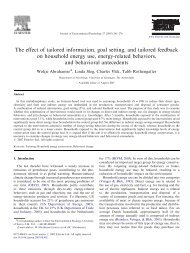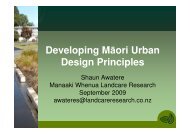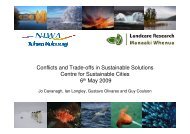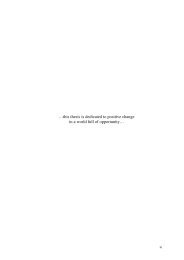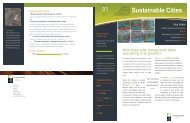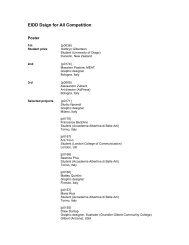Stephen Pattinson: Executive summary of thesis - New Zealand ...
Stephen Pattinson: Executive summary of thesis - New Zealand ...
Stephen Pattinson: Executive summary of thesis - New Zealand ...
Create successful ePaper yourself
Turn your PDF publications into a flip-book with our unique Google optimized e-Paper software.
9<br />
Maslow’s<br />
hierarchy<br />
<strong>of</strong> human needs<br />
2. Safety, security<br />
and protection<br />
3. A conducive<br />
social<br />
environment<br />
#5 - Sense <strong>of</strong><br />
4. A good image,<br />
Community<br />
reputation and<br />
prestige<br />
5. A change to be<br />
creative<br />
6. An aesthetically<br />
pleasing<br />
environment<br />
What a ‘good’ city<br />
should provide<br />
• a visually and<br />
functionally ordered<br />
and controlled<br />
environment<br />
• a place free <strong>of</strong> pollution<br />
and noise<br />
• a place free <strong>of</strong> accidents<br />
and crime<br />
#4 - Needs <strong>of</strong><br />
Children<br />
• a place where people<br />
have their roots and<br />
children their friends<br />
• a sense <strong>of</strong> community<br />
and belonging to a place<br />
or territory<br />
• a place that provides a<br />
sense <strong>of</strong> confidence and<br />
strength<br />
• a place that gives a<br />
status and dignity<br />
• opportunity for<br />
individuals to shape<br />
their personal space<br />
• opportunities for<br />
communities to shape<br />
their own districts and<br />
neighbourhoods<br />
• a place that is well<br />
designed (aesthetically<br />
pleasing)<br />
• a place that is physically<br />
imageable<br />
• a city that is a place <strong>of</strong><br />
culture and a work <strong>of</strong><br />
art<br />
Commonly agreed sustainability criteria<br />
for the city and the city region<br />
Environmental and ecological conditions<br />
• an environment free <strong>of</strong> pollution, noise,<br />
congestion, accidents and crime<br />
• personal private outdoor space for each<br />
individual dwelling in form <strong>of</strong> gardens, ro<strong>of</strong><br />
gardens, terraces, loggias, etc. (without a<br />
return to low-density suburbs)<br />
• a symbiotic relationship <strong>of</strong> the city with the<br />
country through the inclusion <strong>of</strong> open space<br />
linking directly with nature; the spaces to be<br />
used for forestation, farming, large-scale<br />
industries, sports and recreation, for the<br />
production <strong>of</strong> food and timber (for the<br />
construction industry, paper production and as<br />
renewable fuel) to make the city self-sufficient<br />
to as high a degree as possible<br />
Social-economic conditions<br />
• social mix to reduce or eliminate social and<br />
locational stratification, achievable through<br />
higher population densities and a wide range <strong>of</strong><br />
dwelling and tenure types<br />
• a degree <strong>of</strong> local autonomy, the ability <strong>of</strong><br />
individuals and the communities to shape their<br />
own environment according to their needs and<br />
aspirations; this would also support if not<br />
generate a sense <strong>of</strong> place and community, a<br />
sense <strong>of</strong> belonging<br />
• a degree <strong>of</strong> self-sufficiency, with different<br />
degrees <strong>of</strong> intensity, in terms <strong>of</strong> employment,<br />
energy (CHP), water, goods; the city not only as<br />
a consumer but also as producer <strong>of</strong> goods<br />
#2 - Cluster<br />
Housing<br />
Visual-form quality<br />
• imageability <strong>of</strong> the city as entity and <strong>of</strong> the<br />
parts <strong>of</strong> the city, the neighbourhoods, districts<br />
and towns<br />
• provision <strong>of</strong> a sense <strong>of</strong> centrality and place<br />
Table 5.1b Criteria for more sustainable city form. Frey, in Urban Design Reader 2007 (339-340)<br />
Five principles for multivalent communal space correlate with aspects <strong>of</strong> Frey’s agreed criteria<br />
for a more sustainable urban form (highlighted by writer).<br />
© March 2011 <strong>Stephen</strong> <strong>Pattinson</strong> sjpattinson@paradise.net.nz




